|
Light weight but powerful. That is the hallmark
of Smith & Wesson’s Scandium/Titanium revolver
series. For a few years now, I have carried a Smith
& Wesson 342PD .38 Special revolver everyday.
Weighing a bit over eleven ounces, it rides very comfortably in
my pocket. It is always there, always ready. It has never failed
to fire, even after letting it get very dirty with pocket lint,
dust, dirt, sand , sweat, and even chemical fertilizer. Whenever
is have needed it, it has always performed as it should. S&W
has a series of the PD revolvers, all made with titanium
cylinders and scandium frames, which is a special lightweight
but strong aluminum alloy. The PD revolvers wear a durable black
finish, and my 342PD has never exhibited a hint of corrosion
anywhere. Living in the humid Tennessee valley, I have had even
stainless steel guns to rust in my pocket, but not the 342PD.
S&W has several different size and power revolvers in the PD
series, and even a semi-auto or two.
The most powerful of the Smith & Wesson PD
revolvers is the .44 Magnum 329PD, which is the subject of this
review. My first experience with a 329PD was not a good one. I
was handed one by a S&W executive at a shoot as I was
standing on the firing line at a range. It was a very early gun,
and the first that I had seen. I was shooting a Ruger Super
Blackhawk with 300 grain Cor-Bon loads when he handed
me the gun, so I loaded the cylinder of the Smith and touched
one off. Recoil was brutal, and one shot locked the gun up so
tightly that I had to open the cylinder with a brass hammer and
punch out the fired case with a screwdriver. I then handed the
gun back, not shooting another one for a couple of years.
Since introducing the 329PD a few years ago, it
has been a very good seller for S&W. Apparently they work
pretty well, and from the emails that I receive all feedback has
been positive. The 329PD fills a unique role that needed
filling. It offers a lot of power in such a lightweight package.
It carries six shots of .44 Magnum ammo in only a 25.5 ounce
revolver. It is built upon the S&W N-frame, like
Smith’s other .44 Magnum revolvers, but the alloys used in its
construction make the 329PD so much lighter than anything else
available. The trigger pull on the 329PD measured 4.5 pounds in
single action mode, and 10.25 pounds double action. The
barrel/cylinder gap measured five one-thousandths of an inch
(.005"), which is a bit wider than I like, but it is well
within specs.
The 329PD tested came supplied with a good set
of wood grips, but for most of my shooting of this weapon,
I installed a set of much more comfortable Hogue
synthetic rubber grips. With heavy .44 Magnum ammunition, recoil
can be a handful, and the Hogue grips really do help. Even
better would be to install a set of the rubber grips that are
standard equipment on the X-frame .500
S&W revolver. Anyway, for extended shooting sessions
with the 329PD, I wore a PAST shooting glove on my left
hand, and that helped to alleviate some of the sting from the
heaviest loads. While on the subject of recoil with the
329PD, it is all a matter of physics. The lighter the weapon,
everything else being equal, the faster the recoil velocity.
With some very heavy loads, recoil can be painful. However, this
gun is not designed for a full day at the range shooting heavy
magnum loads. This is a defensive and hunting weapon, and in
that role, it works very well. While extended practice sessions
can be painful, it is a weapon with which one needs to practice
to handle it well; just don’t try to shoot too many at one
session. Recoil effects are cumulative, much like hitting your
knuckles with a stick; the more you do it, the worse it hurts.
Sensible practice with the 329PD results in a very useful and
practical defensive revolver.
The sights on the 329PD are a fully adjustable
V-notch rear with a Hi-Viz fiber optic rod front bead. I
like them and hate them. For quick use in the hunting woods or
for social work, they are very good. For precise paper-punching
target work, I greatly prefer a Patridge front and square notch
rear. For the weapon’s intended use, the Hi-Viz is likely a
good choice.
For testing the 329PD, I gathered every type of
.44 magnum, and a few .44 Special, loads that I had available.
The cylinder on the 329PD is plenty long for even the 320 grain
loads. Functioning was perfect, except with most Cor-Bon loads.
With the Cor-Bon Magnum loads, the cartridges fired just fine,
but extraction was very sticky, resulting in having to usually
use a hickory stick to rap on the ejector rod. The Cor-Bon is
very high performance ammo, but so is the Buffalo Bore
and Grizzly Cartridge loads tested, but extraction was
normal with the latter two. While on the subject of ammo for the
329PD, for social work I would carry it loaded with .44 Special
ammo, and the Cor-Bon .44 Special 165 grain JHP worked
perfectly. Buffalo Bore makes a .44 Magnum load especially for
the 329PD. It is a reduced recoil load with offers more power
than the .44 Special, but less recoil than their high velocity
.44 Magnum loads. It is a very popular load with owners of the
329PD revolvers. This load features a 255 grain gas-checked lead
Keith style bullet that does just under 1300
feet-per-second (fps) from the four inch 329PD barrel.
Shooting the 320PD for accuracy and velocity was
pleasurable with some loads, and downright painful with others.
For accuracy testing, I enlisted the help of my Ransom
Rest and let it take the recoil while holding for a
steady shot. The Ransom Rest never tires nor develops a flinch.
The S&W proved capable of good accuracy for hunting,
defense, or informal target work. It would group most any load
within two inches at twenty-five yards, and about half that with
some loads. For reliability testing and just plain fun
shooting, I recruited my good friend Captain Chuck Smith
of the Saint Tammany’s Parish, Louisiana Sheriff’s
Department. Chuck knows his way around a Smith & Wesson
sixgun. In fact, it was he who urged me to review the 329PD.
I tested for velocity with a variety of factory
and handloaded ammunition. The air temperature was around eighty
degrees Fahrenheit. Velocity is listed in feet-per-second, and
was recorded using a PACT chronograph with the screens
set at ten feet from the muzzle. Bullet weights are listed in
grains. JHP is jacketed hollowpoint. WFNGC and WLNGC are
gas-checked cast lead LBT style bullets. Keith is a
semi-wadcutter lead cast bullet. Hawk is a jacketed softpoint.
| AMMUNITION |
BULLET |
VELOCITY |
| Buffalo Bore Reduced Recoil |
255 Keith |
1298 |
| Buffalo Bore Heavy .44 Special |
255 Keith |
996.2 |
| Buffalo Bore Heavy .44 Special |
185 JHP |
1121 |
| Handload .44 Special |
270 Keith |
786.4 |
| Cor-Bon .44 Special |
165 JHP |
1165 |
| Grizzly Cartridge Magnum |
275 Hawk |
1313 |
| Grizzly Cartridge Magnum |
320 WLNGC |
1267 |
| Grizzly Cartridge Magnum |
250 Hawk |
1396 |
| Grizzly Cartridge Magnum |
300 WFNGC |
1286 |
| Cor-Bon Magnum |
320 Cast |
1282 |
| Cor-Bon Magnum |
180 JHP |
1671 |
| Bruin Cartridge Magnum |
250 Keith |
1402 |
The .44 Special loads were all very comfortable
to shoot in the 329PD for extended range sessions, but most of
the .44 Magnum loads were brutal after a few shots. The
exception is the Reduced Recoil loads from Buffalo Bore. These
seem to be the perfect compromise of power and controllability
in the 329PD, and Buffalo Bore sells a lot of these to 329
owners. That 255 grain Keith at almost 1300 fps will do just
about anything that a handgun needs to do. For social
work, either the Buffalo Bore Heavy .44 Special 185 grain JHP or
the Cor-Bon 165 grain JHP .44 Special load would be a good
choice. Another very good load for the 329PD is the 210
grain Speer Gold Dot. The recoil is manageable, and the
Gold Dot bullet expends quickly.
The S&W 329PD fills a unique role in the
handgun world. It carries easily on the hip, and rides
comfortably there until needed. It is almost ideal for hikers,
campers, and fishermen in areas where one needs to go
armed for protection from large carnivores and others creatures.
It is a powerful and handy snake gun when loaded with shot
cartridges, and is very good for resolving social situations of
the gravest kind. I think that it would be a good choice
for most any outdoorsman who needs a powerful weapon but at a
minimum weight. It also serves very well as a defensive
handgun in urban settings for those who prefer a big revolver. A
powerful sixgun like the 329PD is very reliable, packs a huge
punch, and doesn’t leave empty brass laying around the scene.
Sometimes that last quality can be very important in areas where
the local government doesn’t recognize your God-given and
Constitutionally-guaranteed right to carry a gun. If you are
forced to defend yourself, you might not have time to police up
the brass afterward if you are using a semi-auto pistol.
Check out the 329PD and other Smith & Wesson
products online at: www.smith-wesson.com.
To order any of the ammunition listed here, go
to: www.buffalobore.com,
www.cor-bon.com, www.grizzlycartridge.com,
and www.bruincartridge.com.
Jeff Quinn
  
Got something to say about this article? Want to agree (or
disagree) with it? Click the following link to go to the GUNBlast Feedback Page.
|
|
Click pictures for a larger version.
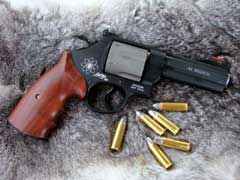
Smith & Wesson’s 329PD .44 Magnum Lightweight Revolver.
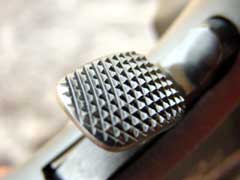
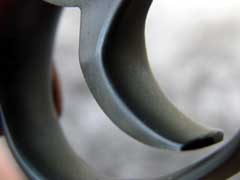
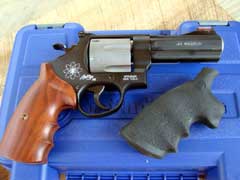
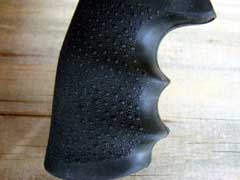
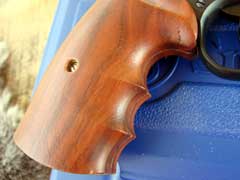
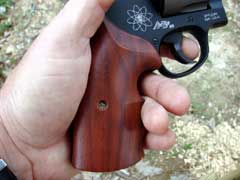
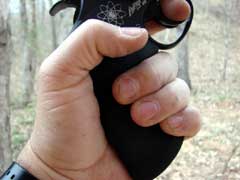
Author tried the 329PD with both Cocobolo and Hogue
rubber grips.
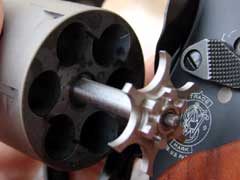
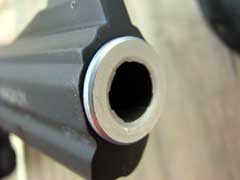
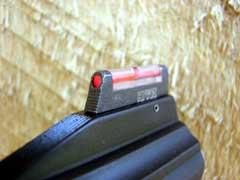
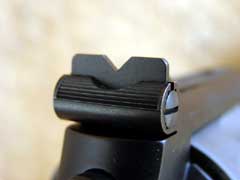
Sights are Hi-Viz front and V-notch adjustable rear.
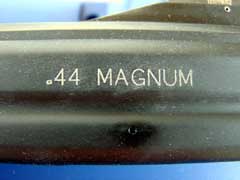
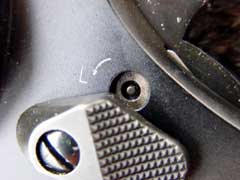
S&W's internal key locking system is standard
equipment.
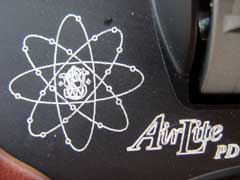
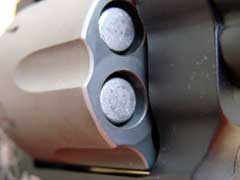
Cylinder is long enough to accommodate most .44 Magnum
loadings.
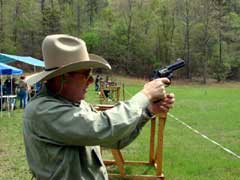
Our friend and brother Shootist, Captain Chuck Smith,
shooting the 329PD.
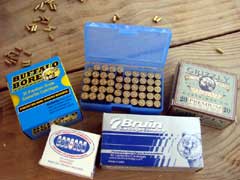
Jeff tested the 329PD with a variety of ammo.
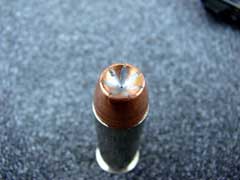
Speer's 210-grain Gold Dot load is a favorite for the
329PD.
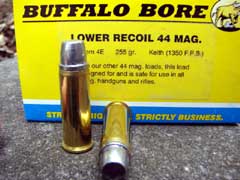
Perhaps the perfect all-around load for the 329PD is
Buffalo Bore's Reduced Recoil 255-grain Keith ammunition.
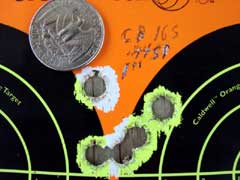
The 329PD proved to be plenty accurate, and packs quite
a wallop on both ends!
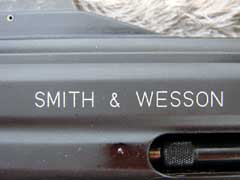
|
![]()